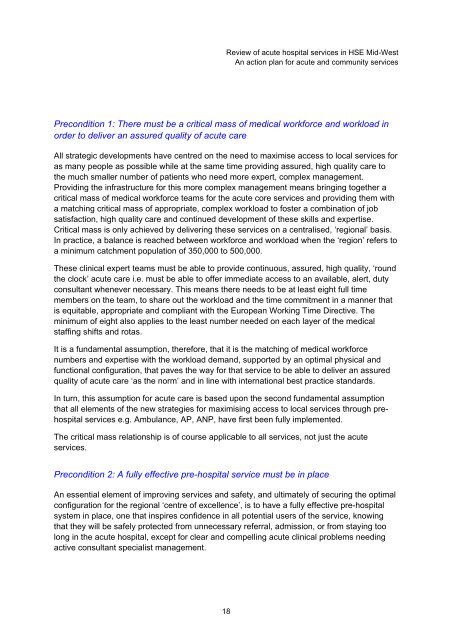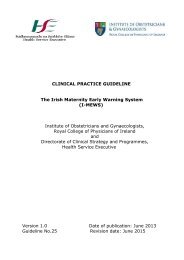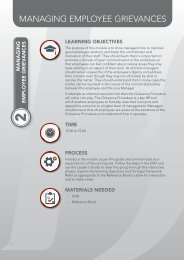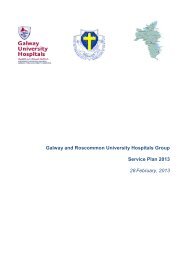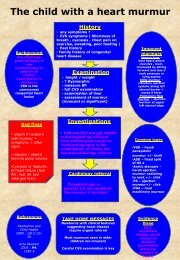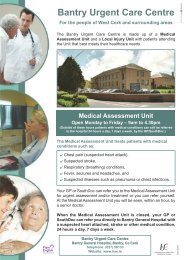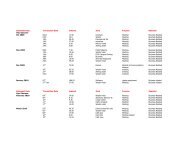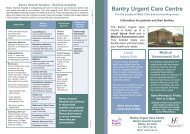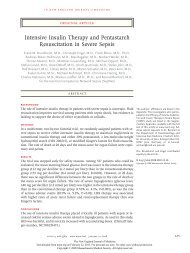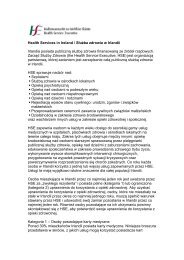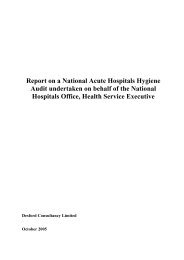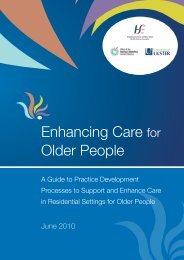Review of acute hospital services in the Mid - Health Service Executive
Review of acute hospital services in the Mid - Health Service Executive
Review of acute hospital services in the Mid - Health Service Executive
- TAGS
- acute
- www.hse.ie
You also want an ePaper? Increase the reach of your titles
YUMPU automatically turns print PDFs into web optimized ePapers that Google loves.
<strong>Review</strong> <strong>of</strong> <strong>acute</strong> <strong>hospital</strong> <strong>services</strong> <strong>in</strong> HSE <strong>Mid</strong>-West<br />
An action plan for <strong>acute</strong> and community <strong>services</strong><br />
Precondition 1: There must be a critical mass <strong>of</strong> medical workforce and workload <strong>in</strong><br />
order to deliver an assured quality <strong>of</strong> <strong>acute</strong> care<br />
All strategic developments have centred on <strong>the</strong> need to maximise access to local <strong>services</strong> for<br />
as many people as possible while at <strong>the</strong> same time provid<strong>in</strong>g assured, high quality care to<br />
<strong>the</strong> much smaller number <strong>of</strong> patients who need more expert, complex management.<br />
Provid<strong>in</strong>g <strong>the</strong> <strong>in</strong>frastructure for this more complex management means br<strong>in</strong>g<strong>in</strong>g toge<strong>the</strong>r a<br />
critical mass <strong>of</strong> medical workforce teams for <strong>the</strong> <strong>acute</strong> core <strong>services</strong> and provid<strong>in</strong>g <strong>the</strong>m with<br />
a match<strong>in</strong>g critical mass <strong>of</strong> appropriate, complex workload to foster a comb<strong>in</strong>ation <strong>of</strong> job<br />
satisfaction, high quality care and cont<strong>in</strong>ued development <strong>of</strong> <strong>the</strong>se skills and expertise.<br />
Critical mass is only achieved by deliver<strong>in</strong>g <strong>the</strong>se <strong>services</strong> on a centralised, ‘regional’ basis.<br />
In practice, a balance is reached between workforce and workload when <strong>the</strong> ‘region’ refers to<br />
a m<strong>in</strong>imum catchment population <strong>of</strong> 350,000 to 500,000.<br />
These cl<strong>in</strong>ical expert teams must be able to provide cont<strong>in</strong>uous, assured, high quality, ‘round<br />
<strong>the</strong> clock’ <strong>acute</strong> care i.e. must be able to <strong>of</strong>fer immediate access to an available, alert, duty<br />
consultant whenever necessary. This means <strong>the</strong>re needs to be at least eight full time<br />
members on <strong>the</strong> team, to share out <strong>the</strong> workload and <strong>the</strong> time commitment <strong>in</strong> a manner that<br />
is equitable, appropriate and compliant with <strong>the</strong> European Work<strong>in</strong>g Time Directive. The<br />
m<strong>in</strong>imum <strong>of</strong> eight also applies to <strong>the</strong> least number needed on each layer <strong>of</strong> <strong>the</strong> medical<br />
staff<strong>in</strong>g shifts and rotas.<br />
It is a fundamental assumption, <strong>the</strong>refore, that it is <strong>the</strong> match<strong>in</strong>g <strong>of</strong> medical workforce<br />
numbers and expertise with <strong>the</strong> workload demand, supported by an optimal physical and<br />
functional configuration, that paves <strong>the</strong> way for that service to be able to deliver an assured<br />
quality <strong>of</strong> <strong>acute</strong> care ‘as <strong>the</strong> norm’ and <strong>in</strong> l<strong>in</strong>e with <strong>in</strong>ternational best practice standards.<br />
In turn, this assumption for <strong>acute</strong> care is based upon <strong>the</strong> second fundamental assumption<br />
that all elements <strong>of</strong> <strong>the</strong> new strategies for maximis<strong>in</strong>g access to local <strong>services</strong> through pre<strong>hospital</strong><br />
<strong>services</strong> e.g. Ambulance, AP, ANP, have first been fully implemented.<br />
The critical mass relationship is <strong>of</strong> course applicable to all <strong>services</strong>, not just <strong>the</strong> <strong>acute</strong><br />
<strong>services</strong>.<br />
Precondition 2: A fully effective pre-<strong>hospital</strong> service must be <strong>in</strong> place<br />
An essential element <strong>of</strong> improv<strong>in</strong>g <strong>services</strong> and safety, and ultimately <strong>of</strong> secur<strong>in</strong>g <strong>the</strong> optimal<br />
configuration for <strong>the</strong> regional ‘centre <strong>of</strong> excellence’, is to have a fully effective pre-<strong>hospital</strong><br />
system <strong>in</strong> place, one that <strong>in</strong>spires confidence <strong>in</strong> all potential users <strong>of</strong> <strong>the</strong> service, know<strong>in</strong>g<br />
that <strong>the</strong>y will be safely protected from unnecessary referral, admission, or from stay<strong>in</strong>g too<br />
long <strong>in</strong> <strong>the</strong> <strong>acute</strong> <strong>hospital</strong>, except for clear and compell<strong>in</strong>g <strong>acute</strong> cl<strong>in</strong>ical problems need<strong>in</strong>g<br />
active consultant specialist management.<br />
18


